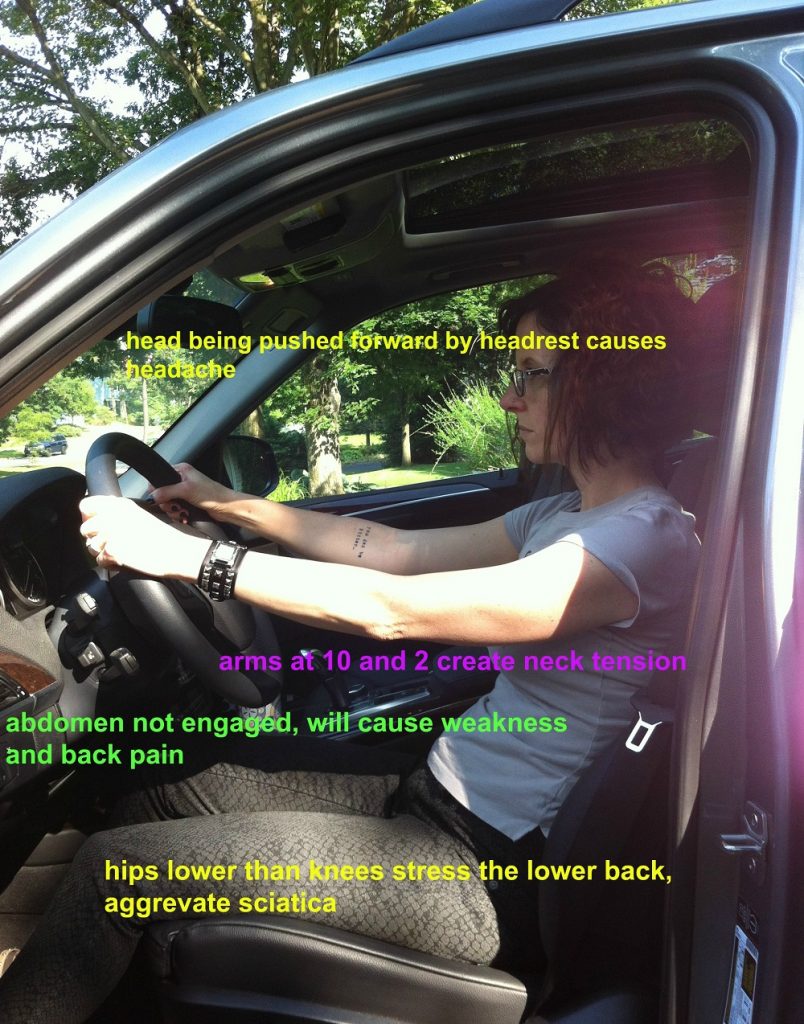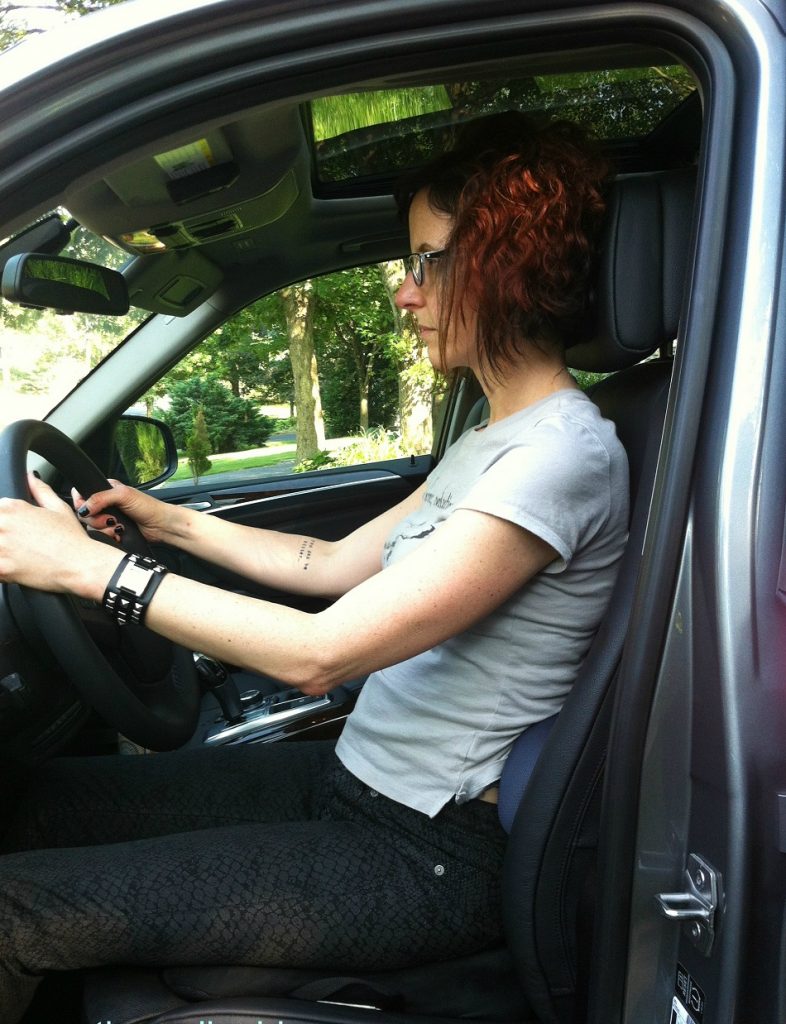Do you love sitting in the car? (No?) It’s vacation season, and that usually means extra long car rides. If you find that driving leaves you angry, tense, and in pain, it might not be just your kids and the other drivers that are causing your angst. Is your car seat position causing you pain?
I have some serious neck issues. Because our ligaments are too flexible, hypermobile people are prone to developing scoliosis as they age, and this can lead to chronic problems, pain and headaches. When I started rehab two years ago, I had cervicogenic headaches every day for 6 months, and until recently that number had improved only slightly. (Yeah, two years of constant headaches has made me a JOY to live with.) The best thing about my physical therapists is that they didn’t just deal with me in their office. They had questions: What mattress am I using? What pillow do I sleep on? How do I sit in chairs? How do I stand when I am waiting? And of course, what do I look like when I drive? All of these factors add up in our day, and either keep you in a cycle of tension and pain, or help break it.
Here is a photo of what I used to look like when I drove, and being that the seat was set to factory standards, it might be what a lot of you look like (Have someone take a picture of what you look in your seat and compare it to my Before Picture)

My PT came out into the parking lot with me, and helped me to rearrange my posture so that I looked like this. I made several big changes that really improved how I felt.

The biggest issue for me was my headrest. My old car had a headrest that angled forward and forced my already weak neck forward. In my research, I learned that headrests are designed differently now to accommodate how large Americans are, and how much they slouch. For people like me with a thin upper body and “good posture,” normal car seat design is terrible. Car companies are becoming aware of this problem, and are starting to modify their headrests so that you can adjust them back. In the meantime, my PT taught me how to pull my head rest out and turn it facing backwards.
It is still there for me to prevent serious whiplash and injury during a car accident, but now the curve faces backwards, not pushing my head forward. I could tell online that some people had removed their headrest entirely to avoid the pain: NEVER DO THAT! You need a headrest. If you can’t turn yours around, hang a thin foam chair cushion around the headrest to bring your back further out and make the angle of the headrest not so severe. I double up on my cushions in certain cars.
I really felt the difference when I lowered the front of my seat so that my hips were level with my knees. I stopped getting a pinching pain in my butt after sitting for periods of time. I did my research to see why, but many “car seat ergonomic” articles not only don’t tell you this, they claim that the opposite (hips below knees) takes pressure off of certain joints. The reason it is important to angle down is because we should sit with our pelvis in a neutral tilt, and when your hips are below your knees, your pelvis tips too far back, like a slouch position. My new car has automatic seats, and they do what I need them to. But in my old car, I used support cushions to do the job:

According to my PT, sit first, then put the half moon wedge pillow behind you as far down as it will go. This also applies to using it in a chair (like the one I am using now to type from).
I find that if I am getting tense and “road ragey” when I am driving, usually my old Drivers Ed class habits have kicked in, and my hands have crept back up to 10 and 2 (o’clock, like your wheel is a clock), as you can see in this picture. I actually got to train with professional race car drivers last year when I did a track experience for Mother’s Day (best.day.ever.), and they said driving with your hands below 9 and 3 actually gives you more control over the wheel. So drop those hands!
Another issue that hypermobile parents especially face, is twisting around to deal with the little passengers behind us. When we deep twist our spine, we can sublux things in our torso, like ribs. I can’t tell you how many times I twisted around to look at my kids, hand them things, etc, and I know now I could never breathe deeply, because I was always straining my intercostals muscles and popping ribs out of place. If you have to deal with your kids, try to do it when the car is parked, and you can get out. Even now that I am aware of my limits, I still occasionally pull out a shoulder when I try to reach behind me and hand them something.
But I know these issues aren’t mine alone…
So here are 10 things you can do to improve your posture in the car:
1. Tilt your seat down so your hips and knees are level, or use a wedge like this one to prop your butt up.
2. Remove thick wallets from your back pocket before sitting down. This causes an imbalance and stress in your hips and low back.
3. Make sure your steering wheel is adjusted low enough and forward enough to minimize having to reach too far to hold it. The center of the steering wheel should point towards your chest, and adjusted as far forward as possible.
4. Use the lumbar support function in your seat, or use a half moon wedge like this one.
5. Adjust the angle of the back of your seat so that you are sitting up, but not too straight. About 100-110 degrees is recommended (90 would be straight up, so a little bit reclined is ideal).
6. Move your seat so that your knees are a comfortable distance from the petals, but your hands can be bent at your side to comfortably take the wheel.
7. Keep your hands at 9 and 3 or below to increase control over the wheel and decrease tension in your neck.
8. Avoid twisting around. Rather, get out of the car to deal with what or who is in the back seat.
9. Make sure your mirrors are properly adjusted. You can adjust rear view mirrors to minimize the “blind spot,” which minimizes how often you need to twist your neck or back before merging or changing lanes. Click here for help.
10. Make sure you have what you need before you drive. Contorting your body to search around bags in the passenger side or behind you can strain your back and neck. Take a minute to set yourself up before you put it in drive.
Hopefully, not only will your back and neck start to thank you, but you may be a little less prone to flipping off strangers for cutting you off. Drivers who feel good are probably safer on the road for everyone.
For more on good posture in the car, check out this article, and for good chair posture, click here.
